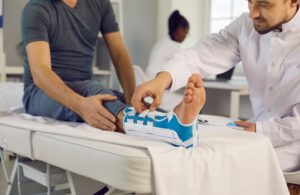How Much is Pain and Suffering for a Car Accident?
How Much is Pain and Suffering for a Car Accident?
When other people drive carelessly or recklessly, they may suffer serious injuries that require invasive medical procedures, doctor visits, and physical therapy. In addition to incurring economic damages, like medical expenses and lost income, accident victims may experience ongoing pain and suffering – sometimes for the rest of their lives. In these situations, accident victims can recover non-economic damages to compensate them for their intangible losses.
If you suffered injuries in a recent car crash, consult a car accident lawyer near you as soon as possible. Your attorney can discuss your options and file a claim for both economic and non-economic damages on your behalf. Your lawyer can then handle all negotiations with insurance company representatives or litigate your case to a successful resolution in court.
Schedule a Free Initial Consultation
Proving Pain and Suffering After a Car Accident
Proving pain and suffering in a car accident case involves demonstrating the physical and emotional distress that you endured as a direct result of the accident. Unlike economic damages, such as medical expenses or lost income, pain and suffering are non-economic damages that are challenging to quantify. Effective evidence for legally proving pain and suffering in a car accident case may include:

- Eyewitness testimony – Eyewitness accounts can offer additional perspectives on the accident victim’s pain and suffering. Statements from individuals who observed the victim’s struggles, emotional distress, or visible injuries firsthand can strengthen the case.
- Photographic evidence – Photographs of injuries, visible scars, and the accident scene can visually convey the full effects of the car crash. These images help corroborate the pain and suffering that the accident victim endured, providing a powerful narrative for the court or insurance claims.
- Medical records – Comprehensive medical records play a crucial role in establishing the extent of physical injuries and associated pain. Documentation from healthcare professionals, including diagnoses, treatment plans, and medications prescribed, provides tangible evidence of the accident victim’s overall suffering levels.
- Written diaries and journals – Personal accounts written by the accident victim in the form of diaries or journals can provide a firsthand record of the daily challenges, pain levels, and emotional struggles that the victim faced in the aftermath of their car accident. These records may also serve as convincing evidence in court.
- Therapy and counseling records – Records from therapy sessions or counseling can offer insights into the emotional toll of the accident on the victim’s mental well-being. Mental health professionals may document symptoms of post-traumatic stress, anxiety, or depression, providing important evidence in the case.
- Prescription medication documentation – The type and dosage of prescribed medications can reflect the severity of pain and emotional distress that the accident victim experienced after their accident. Moreover, documentation of pain management prescriptions supports the argument for significant physical suffering.
- Expert witness testimony – Expert witnesses, such as medical professionals or psychologists, can provide testimony regarding the physical and psychological effects of the accident victim’s injuries. Their experience frequently lends significant credibility to the victim’s pain and suffering claims.
Building a compelling case for pain and suffering damages requires a combination of tangible evidence, expert opinions, and personal accounts. An experienced car accident attorney can help your case satisfy the legal burden of proof so that you can recover the pain and suffering compensation you deserve.
Types of Recoverable Pain and Suffering Damages Following a Car Accident
Pain and suffering damages in a car crash case encompass a broad range of physical and emotional distress that the accident victim experiences. These damages, categorized as non-economic, are subjective and challenging to quantify. Some of the most common types of pain and suffering damages in a car accident case include monetary compensation for:
- Loss of life enjoyment – Car accidents can limit a person’s ability to enjoy life as they did before the incident. Injuries may prevent the accident victim from participating in various activities, sports, hobbies, or social events, contributing to a diminished quality of life.
- Emotional distress – Emotional distress refers to the psychological effects of a car accident. Victims may experience anxiety, depression, post-traumatic stress disorder (PTSD), or other emotional challenges as a direct result of the crash.
- Physical pain – This includes the actual physical discomfort and pain resulting from injuries the accident victim suffered in the car crash. Whether it’s chronic pain, acute pain from injuries, or ongoing discomfort, physical pain is a significant component of an accident victim’s pain and suffering damages.
- Loss of consortium – This type of pain and suffering pertains to the effects of the accident victim’s injuries on their relationships with others. Loss of consortium acknowledges the strain on familial or spousal relationships due to the victim’s physical and emotional struggles stemming from the car accident.
- Permanent disfigurement or scarring – Scarring or disfigurement resulting from a car crash can lead to significant emotional distress. The visible effects of such injuries may affect the victim’s self-esteem and cause them to experience intense psychological suffering.
- Mental anguish – Mental anguish encompasses the psychological suffering that a car accident victim endures. This suffering can include the stress, fear, and mental turmoil resulting from the traumatic experience of the crash.
- Ongoing sleep disturbances – Physical injuries can disrupt a car accident victim’s sleep patterns, leading to insomnia or other sleep disturbances. The resulting fatigue and exhaustion often contribute to the overall pain and suffering that the accident victim experiences.
- Loss of independence – Injuries that limit mobility or require ongoing assistance can lead to a loss of independence. The frustration and emotional effects of relying on others for daily tasks often contribute to an accident victim’s pain and suffering damages.
- Post-traumatic stress – Car accidents, particularly those involving severe injuries or fatalities, can trigger post-traumatic stress disorder (PTSD). Victims may experience flashbacks, nightmares, and heightened anxiety, contributing to their overall pain and suffering.
Proving and quantifying these types of pain and suffering damages often requires a comprehensive approach, combining medical documentation, expert testimony, and personal accounts from accident victims themselves. A skilled personal injury attorney can present a compelling case on your behalf, seeking fair compensation for all of your accident-related pain, suffering, inconvenience, mental anguish, and emotional distress.
How Do Most Car Accidents Happen?
Car accidents can occur for various reasons, but some causes are more prevalent than others. Some of the most frequent car accident causes include:
- Distracted driving – Distracted driving is a leading cause of local car accidents and can take on a variety of forms. With the widespread use of smartphones, drivers often engage in activities like texting, talking, or using navigation apps while behind the wheel. They may also listen to loud music in their vehicle, eat, drink, comb their hair, or apply make-up, all of which can take their eyes off the road and prevent them from seeing another vehicle or pedestrian in the area.
- Drunk or drugged driving – Driving while under the influence of alcohol or drugs poses a serious risk on the roads. Impaired drivers exhibit reduced coordination, impaired judgment, and slower reaction times, making them more likely to cause serious traffic accidents.
- Reckless driving – Reckless driving involves aggressive and dangerous behaviors, such as tailgating other vehicles, aggressively weaving in and out of traffic, and excessive lane changing (or without using a turn signal). These actions can lead to accidents, especially in congested traffic conditions.
- Speeding – Driving at speeds higher than posted limits (or too fast for the prevailing roadway or weather conditions) reduces a driver’s reaction time, making it more challenging for them to avoid obstacles and other vehicles. Speeding accidents tend to result in more severe injuries due to the increased force of the resulting collisions.
If you suffered injuries in a car accident that a reckless or careless driver caused, an experienced car accident lawyer can determine your eligibility for filing a personal injury claim and recovering monetary compensation for pain and suffering. Your lawyer can then handle every step of the process and work to maximize your overall monetary damages.
Where do Car Accidents Most Frequently Happen?
Car crashes can happen anywhere, but certain locations are more prone to accidents due to specific factors. Some of the most common locations for local car accidents include:
- Rural roads – Rural roads, often characterized by narrow lanes and limited visibility, pose many challenges for drivers, including sharp curves. If a driver speeds around a sharp curve too fast, they may lose control of their vehicle, causing a collision with another vehicle or pedestrian.
- Highways and freeways – High-speed roads like highways and freeways witness accidents due to factors such as speeding, aggressive driving, and sudden lane changes by other drivers. The high volume of traffic and the fast-paced environment both increase the likelihood of collisions in these locations.
- Parking lots – Parking lots are hotspots for fender-bender accidents, especially during busy times. Limited visibility, congested spaces, and drivers maneuvering in and out of parking spots often contribute to these collisions.
- School zones – School zones require heightened caution, with children often crossing streets and buses stopping. Accidents in school zones may result from drivers speeding or failing to observe traffic rules, including posted speed limit signs and warning signs.
- Traffic circles and roundabouts – While designed for smoother traffic flow, accidents can still occur in traffic circles and roundabouts due to improper yielding, lane changes, or confusion about who has the right of way.
- Traffic intersections – Traffic intersections are high-risk areas where vehicles traveling in different directions converge. Collisions often occur due to another driver failing to yield the right-of-way, running red lights, or misjudging distance between vehicles.
- Highway merge and exit ramps – Highway merge and exit ramps can be challenging since vehicles frequently (and sometimes abruptly) change lanes to enter or exit the roadway. Sudden merges or failures to yield can lead to serious collisions.
- Residential areas – Residential streets are prone to accidents, especially in neighborhoods with high pedestrian and cyclist activity.
If you suffered injuries in a motor vehicle collision in one of these locations, you need to contact an experienced personal injury lawyer immediately. Your attorney can promptly investigate your car accident circumstances and prepare your claim for filing with the at-fault party’s insurance company.
Seeking Medical Treatment after a Car Accident
Seeking prompt medical treatment after a car crash is crucial for both immediate well-being and the long-term recovery of individuals involved in the accident. Some of the most important reasons you should receive prompt and ongoing medical treatment after your car accident include:

- Early detection of injuries, since not all injuries are immediately apparent after a car crash
- Documentation of injuries (such as medical treatment records) showing that your injuries are directly related to the subject car accident
- Preventing additional medical complications
- Demonstrating to the insurance company that your injuries are serious and that they are deserving of favorable monetary compensation
- Helping you recover monetary compensation for missed work time (such as part of a claim for lost income) if you had to take time off work to attend medical appointments or physical therapy sessions
Ideally, you should continue treatment of your car accident injuries until a medical provider or facility formally discharges you from care. If your treatment records contain significant gaps, the insurance company may question the necessity of your treatment and refuse to compensate you for the full extent of your injuries. However, by treating continuously, you show the insurance company that you suffered serious injuries in your car accident. Consequently, the insurance company may be more inclined to compensate you favorably.
While you focus on your medical treatment, your car accident lawyer can focus on handling the legal aspects of your claim and securing your rights and interests.
Speak with an Experienced Car Accident Lawyer in Your Area Immediately

Greg Bentley, Car Accident Lawyer
After suffering injuries in a car crash, you need to retain legal counsel for representation as quickly as possible. Car accident victims must file a personal injury lawsuit within two years of their accident date. Otherwise, they may inadvertently waive their right to recover the monetary damages they need – including compensation for their pain and suffering.
A skilled personal injury lawyer in your area can immediately enter an appearance on your behalf and file a lawsuit to ensure your case does not exceed the statute of limitations. Your attorney will then pursue the economic and non-economic damages you need to become whole again after your car crash.


